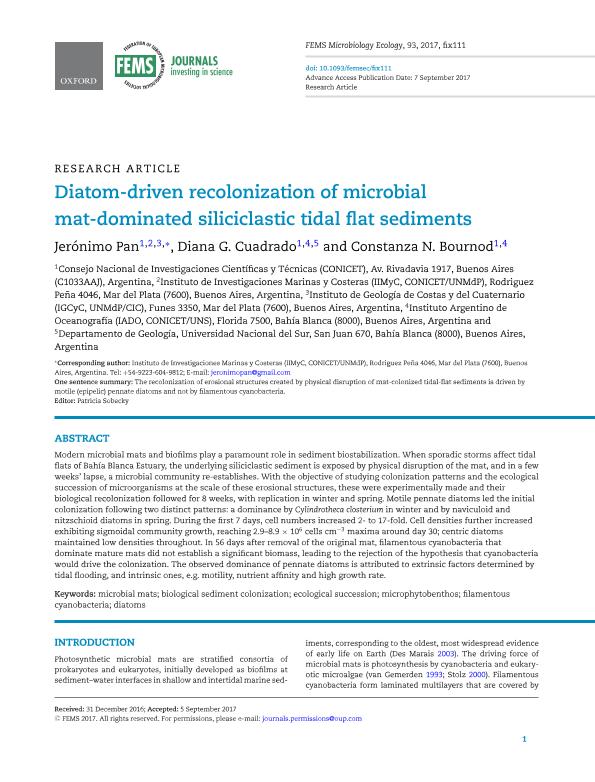Artículo
Diatom-driven recolonization of microbial mat-dominated siliciclastic tidal flat sediments
Fecha de publicación:
10/2017
Editorial:
Wiley Blackwell Publishing, Inc
Revista:
FEMS microbiology ecology
ISSN:
1574-6941
Idioma:
Inglés
Tipo de recurso:
Artículo publicado
Clasificación temática:
Resumen
Modern microbial mats and biofilms play a paramount role in sediment biostabilization. When sporadic storms affect tidal flats of Bahía Blanca Estuary, the underlying siliciclastic sediment is exposed by physical disruption of the mat, and in a few weeks' lapse, a microbial community re-establishes. With the objective of studying colonization patterns and the ecological succession of microorganisms at the scale of these erosional structures, these were experimentally made and their biological recolonization followed for 8 weeks, with replication in winter and spring. Motile pennate diatoms led the initial colonization following two distinct patterns: a dominance by Cylindrotheca closterium in winter and by naviculoid and nitzschioid diatoms in spring. During the first 7 days, cell numbers increased 2- to 17-fold. Cell densities further increased exhibiting sigmoidal community growth, reaching 2.9-8.9 × 106 cells cm-3 maxima around day 30; centric diatoms maintained low densities throughout. In 56 days after removal of the original mat, filamentous cyanobacteria that dominate mature mats did not establish a significant biomass, leading to the rejection of the hypothesis that cyanobacteria would drive the colonization. The observed dominance of pennate diatoms is attributed to extrinsic factors determined by tidal flooding, and intrinsic ones, e.g. motility, nutrient affinity and high growth rate.
Archivos asociados
Licencia
Identificadores
Colecciones
Articulos(IADO)
Articulos de INST.ARG.DE OCEANOGRAFIA (I)
Articulos de INST.ARG.DE OCEANOGRAFIA (I)
Articulos(IIMYC)
Articulos de INSTITUTO DE INVESTIGACIONES MARINAS Y COSTERAS
Articulos de INSTITUTO DE INVESTIGACIONES MARINAS Y COSTERAS
Citación
Pan, Jeronimo; Cuadrado, Diana Graciela; Bournod, Constanza Naimé; Diatom-driven recolonization of microbial mat-dominated siliciclastic tidal flat sediments; Wiley Blackwell Publishing, Inc; FEMS microbiology ecology; 93; 10; 10-2017; 1-13
Compartir
Altmétricas




